

The Caratterista role came out in the Commedia dell'Arte at the beginning of the XVIII century, so quite late, and had no connection with the play:
I would like to see the Caratterista as sort of a drums or bass solo in Jazz, which gives the time to the other musicians to take a break and go drink something or put a new reed on their saxophone.
